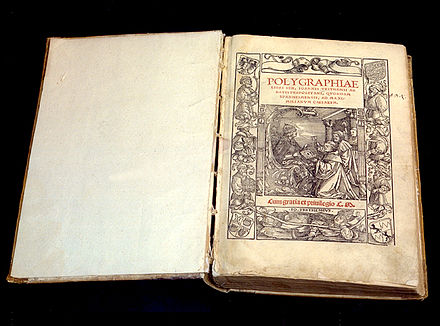
Un libro es un medio para registrar información en forma de escritura o imágenes. Los libros suelen estar compuestos por muchas páginas , encuadernadas entre sí y protegidas por una cubierta . Los libros encuadernados modernos fueron precedidos por muchos otros medios escritos, como el códice y el pergamino . El proceso de publicación de un libro es el conjunto de pasos que intervienen en su creación y difusión.
Como objeto conceptual, un libro normalmente se refiere a una obra escrita de gran extensión, que puede distribuirse físicamente o en formato digital, como libros electrónicos . Estas obras se clasifican en términos generales en ficción (que contienen contenido imaginario) y no ficción (que contienen contenido que representa verdades). Dentro de estas existen muchas categorías más pequeñas, como la literatura infantil destinada a adaptarse al nivel de lectura y los intereses de los niños, o obras de referencia que reúnen colecciones de no ficción. Los libros se comercializan tanto en librerías habituales como en librerías especializadas, y la gente puede pedirlos prestados en las bibliotecas . La recepción de libros ha acarreado una serie de consecuencias sociales, entre ellas la censura .
Un libro físico no necesita contener obras escritas: por ejemplo, puede contener solo dibujos, grabados, fotografías, rompecabezas o contenido extraíble como muñecos de papel . Los libros físicos se pueden dejar vacíos para usarlos para escribir o dibujar, como libros de cuentas , agendas de citas, libretas de autógrafos , cuadernos , agendas y cuadernos de bocetos .
La industria del libro contemporánea ha experimentado varios cambios importantes debido a las nuevas tecnologías. En algunos mercados, la venta de libros impresos ha disminuido debido al mayor uso de libros electrónicos. Sin embargo, los libros impresos todavía se venden más que los libros electrónicos y muchas personas prefieren los impresos. El siglo XXI también ha visto un rápido aumento en la popularidad de los audiolibros , que son grabaciones de libros leídos en voz alta. Además, la conciencia de las necesidades de las personas que no pueden acceder a los medios impresos debido a limitaciones como la discapacidad visual ha llevado a un aumento de formatos diseñados para una mayor accesibilidad , como la impresión braille o formatos que admiten texto a voz. Google Books estimó que hasta 2010 se habían publicado aproximadamente 130.000.000 de libros únicos. ( Articulo completo... )






Crédito: Anne de Felbrigge


.jpg/440px-Spin_Alternative_Record_Guide_(1995).jpg)



{{Portal|Books}}Los siguientes proyectos hermanos de la Fundación Wikimedia brindan más información sobre este tema: